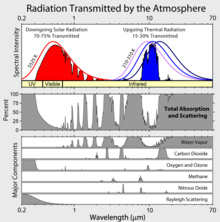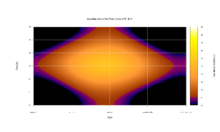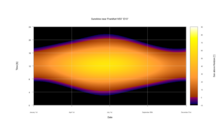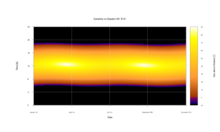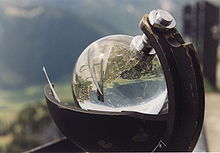sunshine
Two things are referred to as sunshine : the light of the sun (i.e. the effect of the sun's rays on the earth ), and weather conditions with little or no cloudiness . Sunshine prevails when the rays of light coming from the sun between sunrise and sunset - i.e. during the day - reach the surface of the earth .
Physical-biological aspects
If the sun is covered by clouds or other objects during the day , these cast a shadow on the surface of the earth. In the shaded areas, however, there is by no means darkness , because there, too, there is diffuse reflection in the atmosphere. The higher and clearer the air, the more the sky brightness differs in sunny weather and cloudy weather . For this reason, approaching thunderclouds appear more threatening in the mountains than elsewhere. Even at night there is no complete darkness, so the light of the moon forms the moonlight .
Our eyes adapt so well to the brightness of the environment that we are seldom aware of it. This is physically noticeable on the iris , which shows a much smaller opening in sunshine than in cloudy weather. This principle, which can often be observed in nature (even on the stomata of plants), is also implemented in the automatic exposure of cameras, which reduce the large amount of light in sunshine either by a smaller aperture or a shorter shutter or exposure time.
Sunshine and solar energy
Under global radiation is meant the per horizontal surface incoming total radiation power of the sun in W / m 2 . It is composed of direct solar radiation and radiation scattered diffusely by clouds and air and is measured with a pyrheliometer .
In space, the undamped radiation output is 1367 watts per square meter and is called the solar constant . Only a fraction of it reaches the earth's surface. Reasons for this are losses due to the oblique angle of incidence and the earth's atmosphere (air envelope and possibly cloud cover).
For Germany this results in an averaged value of 110 W / m² over day and night, sunshine / cloudiness and geographical latitude. This value is highest in sunshine.
- Sunshine, clear to slightly diffuse sky
- Summer: 600–1000 W / m²
- Winter: 300–500 W / m²
- Sunshine with light to medium clouds
- Summer: 300–600 W / m²
- Winter: 150-300 W / m²
- very cloudy to foggy-cloudy
- Summer: 100–300 W / m²
- Winter: 50–150 W / m².
For Austria the values are 10-14 percent higher. On the one hand, the average sunshine duration is 6% higher, on the other hand, the radiation is around 4 ° steeper.
Most plants use the energy of solar radiation for photosynthesis by covering the energy needs of chemical syntheses by absorbing light. Humans have always used solar energy, for example in the type of building that is shaped by the climate, for the preparation of hot water (dark containers) or for cooling through evaporation. In the last few decades, a special solar technology has become established, the conversion of solar energy into heat using so-called solar collectors (see solar thermal ). In contrast, photovoltaics work through their direct conversion into electrical energy (see solar power ).
Sunshine duration
In the geosciences, a theoretical period of time is often calculated in which a cloudless and unclouded, clear atmosphere, unhindered by mountains on the horizon, enables sunshine at a certain location. It is called the theoretical or astronomical sunshine duration and depends on the latitude and the season (see also the position of the sun ). At locations in the mountains or hill country, it is shortened by the landscape horizon. Any shading by buildings, however, is not included in the value.
The actual duration of sunshine is, however, much shorter and depends largely on the climate zone . For the most part, it is clouds that prevent sunshine, but other causes such as smog can also contribute to the fact that the sunlight only reaches the earth's surface in a subdued manner. Furthermore, sandstorms or the volcanic ash thrown into the atmosphere during volcanic eruptions can dampen solar radiation.
The duration of sunshine is used to approximate the irradiation at a certain location and at the same time provides information on the time and thickness of the cloud cover. The actual duration of sunshine is defined as the period of time during which the direct solar radiation perpendicular to the direction of the sun is at least 120 W / m 2 .
The actually possible sunshine duration is shortened by landscape horizons, so that the sunshine duration in December in certain valleys in the mountains can even be zero.
The relative sunshine duration describes the proportion of the actually possible sunshine duration in percent. They can be used to compare sunshine conditions in different areas.
Duration of sunshine in Germany
The average annual sunshine duration in Germany is between 1300 and 1900 hours per year, depending on the location. The average is around 1550 hours of sunshine per year.
- Maximum annual sunshine duration: 2329 hours in 1959 on the Klippeneck on the southern edge of the Swabian Alb (973 m)
- Shortest annual sunshine duration: 936.7 hours in 1912 in Münster
- Longest monthly sunshine duration: 402.5 hours in July 1994, Cape Arkona / Rügen
- Shortest monthly sunshine duration: 1.2 hours in December 1993 in Lüdenscheid (Zeppelin-Gymnasium)
Statistically, on most continents the duration of sunshine increases with decreasing geographical latitude. Exceptions are the tropics and partly the polar regions. In Austria, the duration of sunshine is on average around ten percent higher than in Germany.
Measurement method
The most common measuring device for the duration of sunshine up to around 2000 is the Campbell-Stokes sunshine autograph . With this device, the sun's rays are bundled by a spherical glass lens so that they burn a trace into a dark, scaled strip of paper . From the length of this burning track, the duration of the sunshine can be read off to within a tenth of an hour. The strips are changed daily.
Nowadays photoelectric sensors ( pyranometers ) are also used to measure the duration of sunshine. The sensors measure the sunshine duration indirectly. They measure the irradiance ; if this exceeds the internationally established limit of 120 W / m 2 , sunshine is assumed and a signal is output.
Overall in Germany u. a. around 300 stations (as of 2016) of the German Weather Service sunshine measurements.
Web links
- Java sunshine applet with the possibility of calculating different sizes
- sonnenscheindauer.de - a technical paper on the theoretical sunshine duration
Individual evidence
- ↑ Koblin, Wolfram et al., Handbook Passive Use of Solar Energy, Ministry for Regional Planning, Building and Urban Development, Bonn (1984)
- ^ HMSO: Tables of Temperature, Humidity and Sunshine for the World , Vol.III (Europe), London 1972
- ↑ Info at Thiesclima.com
- ↑ Time series of the German Weather Service , as txt
- ↑ Kaspar, F .; Mächel, H .: Observation of climate and climate change in Central Europe and Germany , Chapter 3 in: Climate change in Germany , pages 17-26, ISBN 978-3-662-50397-3 , doi: 10.1007 / 978-3-662-50397 -3_3 , Springer, Berlin Heidelberg 2016. PDF via link.springer.com

